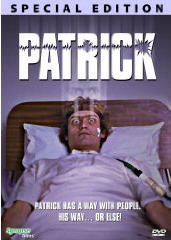
Mental telepathy and such unexplored areas of the human mind as ESP are a fascinating if not very often exploited theme. Relatively few films have dealt with the issue, with Carrie, Firestarter, and The Fury remaining the most known. Limited to neither the supernatural or science, this subject overlaps both arenas, encouraging versatility and a slew of promising ideas for the creative filmmaker. Patrick, directed by Richard Franklin, deals with its title character's telekinetic powers in a direct but subtle manner, emphasizing believable but sometimes odious relationships over grue. A tightly structured story favouring quiet terror and characterization over graphic violence or shocks, Everett De Riche's screenplay takes its time creating claustrophobia and suspense. The wait is well worth it, evoking belief in the conflicts and faith in the supernatural horrors.
Patrick (Robert Thompson) is a comatose patient in the private Roget Clinic, a vegetable since the afternoon he murdered his mother and her lover. Years later Kathy, a nurse recently separated from her husband, finds work at the clinic, and discovers that Patrick is little more than a lab rat for the obsessed and cruel hearted Dr. Roget, who spends his time murdering frogs and experimenting on Patrick to investigate the grey moment between life and death. Icy head nurse Matron Cassidy dislikes Kathy almost as much as Patrick, and our warm hearted nurse soon finds out why. One day she discovers that Patrick is capable of communicating with her via telepathy and a typewriter. What she doesn't immediately realize is that he's also capable of trying to drown her lover and other assorted nastiness. As her desperation to help him increases, so does his jealous rage.
One of the more reputable efforts from Australia, Patrick draws as much scorn as it does fans. Several horror fans lament the lack of solid action, the slow pacing, and a conscious lack of outright violence. While these charges aren't without merit, with the unsteady structure and meandering pace diminishing the overall effect of an otherwise engaging suspense story, the very problems that some critics site for the movie's failure are, in fact, the very reasons why the movie more often than not succeeds. By taking the time to craft revealing moments of characterization and supernatural suggestion, director Franklin lends empathy to the plight of people we learn to like and understand. This slow burn method is particularly necessary for an understanding for Patrick, who spends much of the film laying in bed. The dramatically subtle interplay between him and the nurse, as well as the sub-plots of her failed marriage and romance, intermesh smoothly and naturalistically. In short, they pave the way for the more terrifying occult nightmares to follow. Richard Franklin displays a sure hand with atmosphere and character building, injecting admirable realism into a subject that could have easily seemed contrived and unconvincing.
Patrick suffered the fate of several foreign releases when it hit our US shores, cut by several minutes. Released some years back by elite, this Aussie cult classic is now presented anamorphically with the same extras ported over. Synapse offers this intriguing suspense thriller in 1.78:1 widescreen, sporting sharp images, very little grain, and colors that are solid and believable. Sound is featured in Dolby Digital Mono, including the original English track with Spanish and French options.
Extras are informative and solid in creating context for the film, thanks primarily to the Audio Commentary with Franklin, who throughout his conversation exhibits his commitment to the art, a solid directorial method, and dedication to Hitchcock. Also included are both an Australian and American Trailer as well as three U.S. TV spots.
Review by William Simmons
| Released by Synapse Films |
| Region 1 - NTSC |
| Not Rated |
| Extras : |
| see main review |